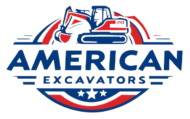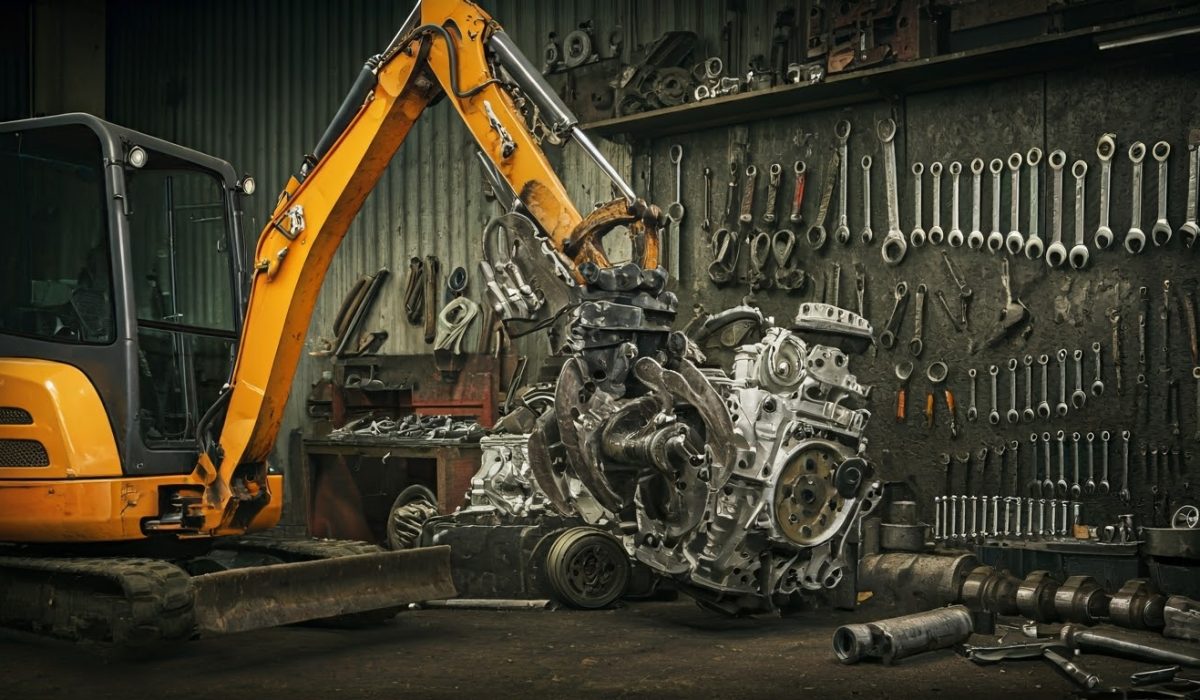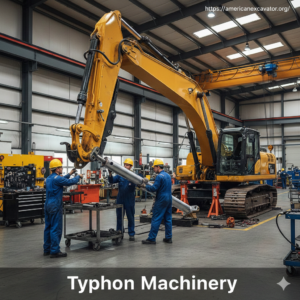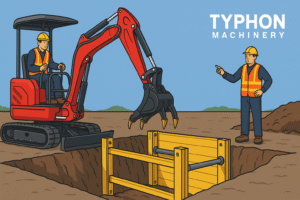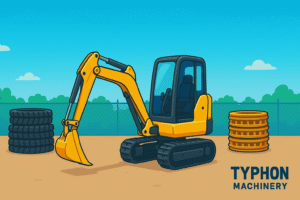Industrial Mini Excavator Top Critical Spare Part List
Will you manage the situation if you face unexpected machines break down in your industrial mini excavator? The answer is quite simple – make sure you possess the most important spare parts to guarantee that downtime is negligible.
Industrial mini excavators spare parts cover hydraulic, filters, track system, and engine parts. If you have the crucial part with you, it takes only a few minutes to remove the cause of the problem and it can be solved immediately.
We have provided the 15 efficient replacement parts that every mini excavator owner should add to their maintenance arsenal. You can manage these important machines, whether it’s one or a whole fleet:
- Reduce unexpected downtime
- Save on emergency repair costs
- Extend your equipment’s lifespan
- Maintain optimal performance
Let’s take a closer look at the main spare parts that will not let your mini excavator to shut down any trouble at all and will run with full force all the time.
Key Takeaways:
- Necessary hydraulic components and filters for proper system maintenance
- A key to the track system optimization process which means the right track tension and flexibility
- Main engine components for ensured smooth running of the mini excavator
- Regular maintenance as well as fix and repair due to unexpected occurrence demand spare parts
- Components for safety control and attachments that must be taken with extra care are very sensitive indeed.
Must Have Top Critical Spare Part List for Every Mini Excavator:
Essential Hydraulic System Components
One of the things that give small hydraulic excavators their power is the hydraulic systems which convert mechanical power into fluidic power that moves tasks. A well-maintained hydraulic system ensures the utility of your machinery remains at an optimal level and that the life of your equipment is significantly extended.
Hydraulic Filters and Fluids
The primary component of the hydraulic system of a mini excavator, its filters and fluids, may be called the system’s heart. Hydraulic filters of high quality are significant robustness hydraulic components that inhibit contamination and save the system from tear and wear. These filters capture the bad particles and guarantee a smooth flow of uncontaminated fluid in the system.
It is the regular checks and changes of the fluid that are essential for a system to run efficiently. The hydraulic fluid does not only pass the power but also acts as a lubricant and a cooling agent for the system components. In addition to using the manufacturer-recommended fluid type, correct fluid levels have to be maintained to prevent system damage and extend component life.
Hydraulic Pumps and Motors
Your mini excavator’s arm, boom, and attachments run smoothly because the hydraulic pump pressurizes the hydraulic fluid. A defective pump might cause a power outage and inefficient equipment.
Hydraulic motors and pumps convert fluid power to mechanical energy. These sturdy components must be regularly inspected for malfunction. Pump and motor noise is a warning of system collapse and should never be ignored.
Pumps and motors need optimal pressure levels. Regular pressure testing is the best approach to spot issues and fix them before they worsen. Since seals and gaskets are changed most often during maintenance, always carry extras.
💡 Key Takeaway: A hydraulic system that has been properly maintained with top-notch filters, the right amount of fluid, and in good working condition pumps and motors is one of the key factors that contribute to your mini excavator’s performance and longevity.
Important Engine and Power Components
Filters and Maintenance Parts
Changing filters and vital components regularly keeps your mini excavator engine healthy. A fuel filter, air filter, and oil filter are essential for engine protection from foreign particles.
These are the most crucial engine components to examine and repair to avoid failure. A dirty fuel filter may starve your engine, while a dusty air filter reduces engine performance and increases fuel consumption. If the oil filter fails to hold metal and other particles, the engine might be damaged quickly.
Ignition and Starting System
The ignition and starting systems directly drive the micro excavator, making them crucial. The starting motor, alternator, and battery compose the system.
A defective starting motor may leave you useless at work, while a broken alternator will not charge your battery, creating shutting down issues. The key component that requires frequent corrosion, fluid level, and condition checks is the battery.
These power components must be maintained to prevent costly downtime. Regular voltage monitoring and electrical fitting cleaning may help identify possible problems before they become major concerns.
💡 Key Takeaway: Consistent filters and power part maintenance keep the mini excavator in top condition, and the frequent checks with timely replacements also prevent unanticipated repair.
Track System Components
Track systems are the main parts that make sure the mini excavators run smoothly and are mobile. As a rule, these systems should be regularly serviced and be replaced after some time to guarantee high performance and to avoid major breakdowns altogether.
Track Tensioners
A significant part of the track is the tensioner. This component is responsible for keeping the track in place, as well as keeping the machine’s stability and performance at a very good level. When tracks are too loose, they cause the machine to derail or the other parts to wear in excess.
On the other hand, too tight tracks can cause an overload, which will make the drive system fail prematurely.
It is advisable that you regularly check the condition of your track tensioner to spot potential problems at their early stages. Examine the tensioning cylinder for signs of wear, cracks, or leaks. The grease fitting, which is the grease nipple, should also be checked for dirt and functionality, and if it is clean, then it can still be used for the next tension adjustment.
Idler Wheels
Idler wheel track chain guides hold it in place, reducing wear in other sections. Wheels are under a lot of strain during labor, therefore they must be checked for wear, damage, and bearing concerns.
Idler wheel inspections should focus on unusual sounds, free movement, and contact surface wear. However, malfunctioned or worn idler wheels cause the track to move off-center, increasing the risk of derailment and accelerating wear on neighboring sections.
Maintenance of track tensioners and idler wheels without frequent cleaning, lubrication, and mounting hardware security is improper. Proper maintenance and a preventative approach to extend component life and optimize excavator performance are still maintained.
💡 Key Takeaway: Regular idler wheels and track tensions maintenance is an important factor to be considered to ensure that the track is properly tensioned, that no wear occurs prematurely during the operation of the excavator, and that it continues to operate efficiently and longer with the optimal performance.
Attachment Connection Parts
Quick Connect Systems
When using a mini-excavator attachment, speed and efficiency are key. Working folks need quick connect systems to swap attachments easily. These systems use synchronized bushings, pins, and hydraulic couplers to provide tight attachment connections.
The ability to save repair time is the main benefit of having a spare set of fast connect components. If the original components wear out or break, spare parts may be used to swiftly fix the machine and restore its functionality without waiting for new parts.
For best performance, be sure to stock the following key quick connect components:
- Hydraulic quick couplers
- Mounting pins
- Locking mechanisms
- Bushing sets
- Connection plates
These components are created to satisfy the job’s requirements and at the same time ensure safety and reliability. Regular examination and maintenance of these parts keep failures under control and keep the machine adaptable.
It is advisable to have several sets of mounting hardware as they are subject to constant pressure during operation. Having spares that are easily accessible enables you to continue to be productive even if there is unexpected wear or damage.
💡 Key Takeaway: The availability of crucial quick connect system components like pins, bushings, and hydraulic couplers sets the stage for flexibility and efficiency of the mini excavator attachment and thus is a good way to pare down operational downtime.
Maintenance and Safety Components
A regular schedule for maintenance is extremely important in making sure that your mini excavator is running safely and with high efficiency. Proper attention to maintenance and safety components can reduce unexpected breakdowns besides which it also ensures continuous and top performance during the operations.
Grease Fittings and Lubrication Points
Grease fittings and lubrication points are among the most prominent components that denote a regular maintenance schedule. These components, by virtue of their significance, should be given constant care and attention to ensure smooth operations and also not to allow for premature wear and tear of moving parts.
Adequate lubrication acts as an important safety precaution by diminishing the friction between the moving parts, preventing overheating, and eliminating the possibility of component failure. Areas in your machine that require regular greasing are listed as follows:
- Boom pivot points
- Bucket linkage joints
- Swing bearing
- Slew ring assembly
- Track roller frames
Before running a machine, establish and follow a comprehensive lubrication plan for the above locations and examine them regularly. The manufacturer-specified lubricant must be applied for optimal component performance and longevity.
Before applying greasing compound, each fitting should be cleaned to eliminate dust and grit that might hinder operation. This simple but critical maintenance operation may considerably extend the life of machine moving components.
Please record all lubricating actions in your maintenance journal. This keeps call/visit logs and detects wear patterns before they become irreparable.
💡 Key Takeaway: A regular castor grease of the lubrication points is a basic safety measure that not only prevents early component wear but also keeps your mini excavator on track and running smoothly, absolutely eliminating any downtime factor.
Bucket and Attachment Wear Parts
To ensure that the mini excavator’s bucket and attachments are always at their peak performance, it is very vital that a complete set of wear parts is always available. Due to the continuous friction and load during operation, the components experience not only regular but high wear and tear, so it is crucial to be prepared with a set of wear protection components and replacement bits.
Teeth and Cutting Edges
Teeth and cutting edges of your narrow bucket attachment are the first to deteriorate since they touch the ground. These components come in various sizes for bucket widths and uses.
Worn bucket teeth reduce digging efficiency and increase fuel use, so inspect them often. Each time you adjust teeth, check adapters and pins for wear and appropriate fitting and function.
Knife edges protect the bucket’s front and increase material penetration. They usually come in sets that may be changed without changing the bucket. The substance being dug affects wear, thus you may use various knife edges.
Maintaining sharp knife edges for unusual attachments like trenching or skeleton buckets is essential for clean, efficient cuts. Abrasive material workers might consider reinforced steel knife edges.
💡 Key Takeaway: Get the various sizes of the tooth and knife replacements and keep them in stock to significantly reduce downtimes, as these very parts are the ones that directly impact your mini excavator’s digging efficiency as well as operational costs.
Parts Sourcing and Quality Considerations
If you want to keep your mini excavator’s performance at a high level, it is vital to find the parts supplier that will meet your requirements. In this respect, the reliability and lifespan of your machine are directly dependent on the quality of replacement parts you choose.
OEM vs. Aftermarket Options
Original Equipment Manufacturer (OEM) parts are the ones directly provided by the excavator’s manufacturer, thus ensuring that they are a perfect fit for this equipment and at the same time guarantee the highest quality standards. In the majority of the cases, the parts are more expensive, but their warranties are usually better and the performance is guaranteed.
Aftermarket parts, which are developed by companies other than a vehicle manufacturer, are the cheaper solutions available. A lot of reputable producers of auto parts are the source of aftermarket parts that either meet or exceed the specifications of the original equipment manufacturer (OEM). In the case of this kind of replacements, it is important to check the certification and tests of the producer.
If you are undecided between the choices of OEM and aftermarket parts, then you can be guided by several factors, which include the availability of the part, cost, and warranty. The right vendor should stock both types of products thus giving you a chance to settle for one or the other depending on your specific needs and the amount of money you can afford to spend.
💡 Key Takeaway: Regarding quality, OEM parts are the best option for a guaranteed match and aftermarket parts are the means to save money; the restriction should be that your parts supplier maintains high quality standards as well as adequate certifications.
Conclusion
Maintaining important replacement parts in your inventory is crucial for maintaining and improving mini excavator uptime and operating efficiency. By keeping these 15 essential components on hand, you can prevent future equipment breakdowns and increase the durability and productivity of your organization.
Regular maintenance and proactive stock management may significantly reduce unexpected downtime and emergency repair expenses. Hydraulic components, filters, track systems, engine parts, etc. are necessary for optimum machine operation and longevity.
Restocking that inventory today ensures a rapid and efficient reaction to whichever product line is struggling. Starting the spare parts shop requires inventorying the current stock and adding the recommended goods. Buyers should deal with trusted suppliers that deliver quickly and provide high-quality goods. Your mini excavator’s performance and project success rely on your readiness and proactive maintenance.
FAQs
What is the average lifespan of mini excavator parts before they need replacement?
In the majority of cases, costs of spare parts for mini excavator are between $ 2,000 and $ 5,000 and can operate for about 5,000 working hours when used regularly. Nevertheless, mechanical parts such as filters, tracks, and hydraulic hoses might be required to be replaced more often based on the length of usage and the working environment. In fact, by doing regular maintenance, the parts can be extended to their peak performance.
How can I identify genuine vs. aftermarket parts for my mini excavator?
If the merchandise shows the manufacturer’s marks, the serial numbers, and has the right packaging, it is original. In comparison, the use of cheaper aftermarket parts can affect the compatibility, reliability and the warranty offered by the OEM parts. Only certified retailers who have the genuine parts should be contacted for the sources of parts.
What are the signs that indicate hydraulic system components need replacement?
If there is an uncommon noise, slow movement, fluid leakages, overheating or movement is not smooth during the operational process, these are all signs of worn-out hydraulic components. Regular fluid analysis and pressure testing can bring to light these problems before they become major malfunctions.
How often should I inspect my mini excavator’s undercarriage components?
On a daily basis, the service should include eyes on the tracks, rollers, and sprockets. It is a must to make a visual a little deeper examination of the undercarriage after every 100-200 operating hours. It is crucial to make sure that tracks are in the right tension, the wear patterns are good, and they are straight. If replacement is needed, wear can be eliminated before the damage is done and the digging process can be kept at an ideal stage.
I want to know what precautions need to be taken when I have to replace excavator parts?
Always park your machine on the flat ground, down the attachments, turn off the engine, and remove the hydraulic pressure to prevent accident. Make use of correct lifting tools, always dress in proper PPE and strictly adhere to the manufacturer’s rules. You have to keep full maintenance records and use the correct technical datum for the parts.
Are there mini excavator parts that I can replace, or should I just leave them as they are?
Quite a good many parts can be replaced so that the machine can work better. In this case, the user can consider the use of heavy-duty tracks for rough terrains, special buckets for specific jobs, and the tough hydraulic parts for more power. Make sure to get the advice of your parts suppliers to ascertain the compatibility.
